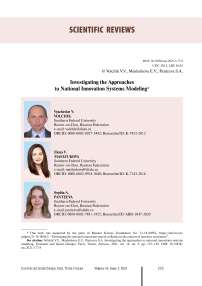Investigating the Approaches to National Innovation Systems Modeling
Автор: Volchik V.V., Maslyukova E.V., Panteeva S.A.
Журнал: Economic and Social Changes: Facts, Trends, Forecast @volnc-esc-en
Рубрика: Scientific reviews
Статья в выпуске: 5 т.14, 2021 года.
Бесплатный доступ
The article analyzes some modern approaches to modeling national innovation systems that are presented in scientific literature. We use modern methods for analyzing bibliography and preparing literature reviews: co-occurrence, and the PRISMA (Preferred Reporting Items for Systematic Reviews and Meta-analyses) method. With the help of this approach we conduct relational analysis of documents by systematizing and arranging keywords into special semantic clusters that reflect interest in modeling national innovation systems. The research focuses on mathematical models of national innovation systems and models that use empirical quantitative data analyzed with the help of various econometric methods based on the Russian specifics of economic development. In this regard, when searching for and analyzing relevant sources, we used the filters “Russian innovation system”, “national innovation system and Russia”. We have revealed that the majority of publications focuses on such aspects as digitalization, neo-industrialization, innovation policy and technology. We identify four directions for modeling national innovation systems: macroeconomic modeling of innovation systems, modeling of growth based on the development of innovation systems, modeling of innovative activity of firms, modeling of institutional factors contributing to the development of innovation systems. The national innovation system is modeled mainly through the use of indicators related to patenting, the volume of exports and the production of innovations. Factors determining the development of national innovation systems in this context include R&D and innovation expenses, investment in technology, education, infrastructure, human resources and the quality of human capital. Conclusions on the analyzed models often do not coincide regarding the role of the state in financing innovations, the role of various elements of the institutional structure of the economy, such as intellectual property rights and mechanisms for their protection, as well as the role of political factors. On the other hand, the conclusions are consistent in terms of the impact of innovation on economic growth and development: we note a positive correlation with indicators reflecting the development of national innovation systems.
Innovation, national innovation system, economic growth, institutional structure, economic policy, Russian innovation system
Короткий адрес: https://sciup.org/147234812
IDR: 147234812 | УДК: 338.2 | DOI: 10.15838/esc.2021.5.77.8
Текст научной статьи Investigating the Approaches to National Innovation Systems Modeling
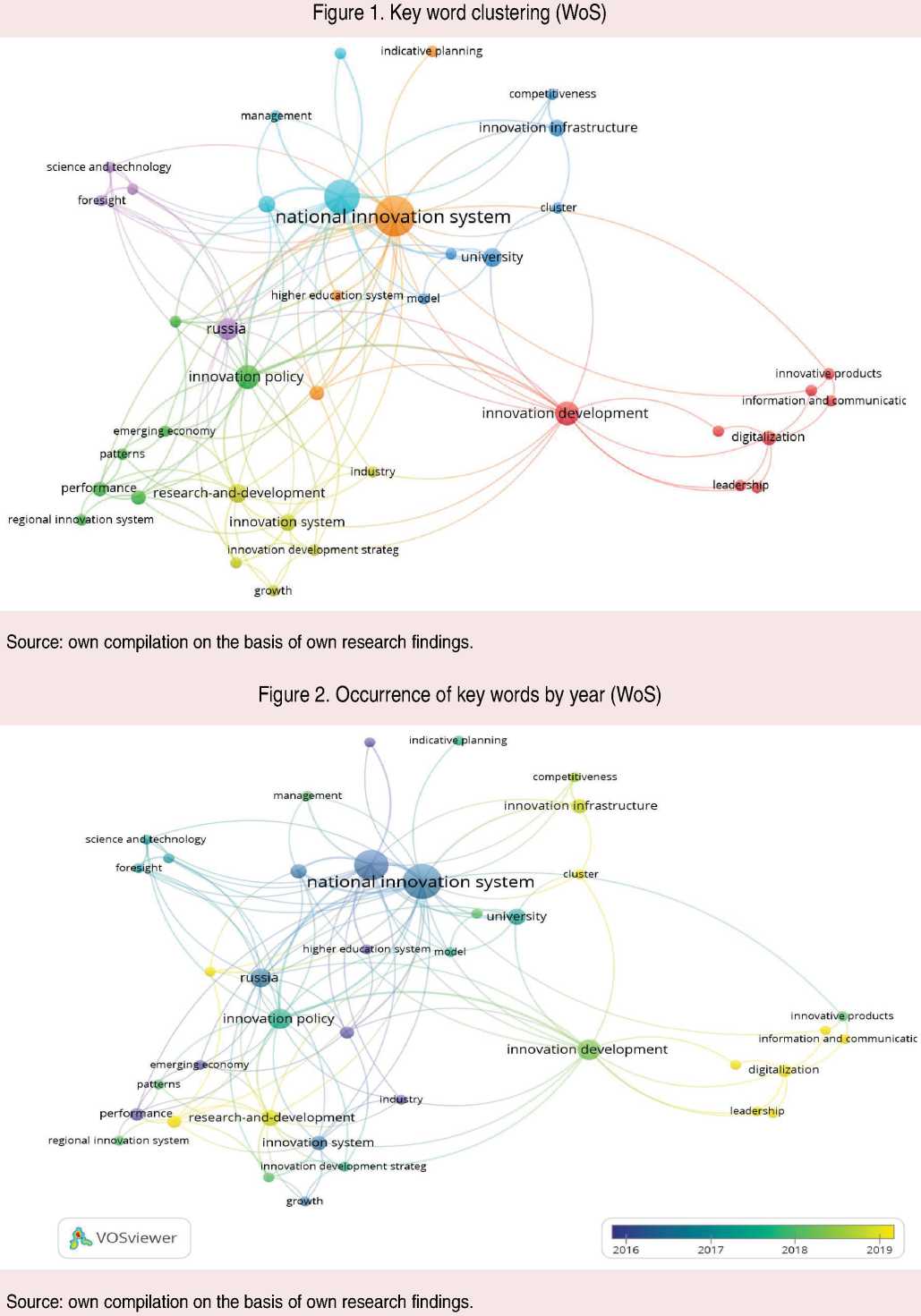
in which both terms occur together. Thus, 39 out of 284 terms were used for clustering. Figure 1 shows authors’ keywords divided into eight clusters, and Figure 2 shows a network with overlap of publication year, i.e. it is shown which words were used most often in publications in a particular year.
The most extensive cluster (highlighted in red in Fig. 1) includes such terms as “digitalization”, “information and communication technologies”, “innovation development”, “innovative economy”, “innovative products”, “leadership”, “neoindustrialization”, “transformation” – they are related to research on innovation development. Next, we see the terms “growth”, “industry”, “innovation development strategy”, “innovation system”, “research-and-development”, “spillovers” (green cluster) – they are related to research and development. We should note that the terms “higher education system” and “university” are included in different clusters: the former is in conjunction with “innovation policy”, “national innovation system” and “indicative planning”, and the latter is combined with the terms “innovation infrastructure” and “competitiveness”.
Clustering and occurrence of key words by year in Scopus are shown in Figures 3 and 4 . Clustering is based on the number of matches of at least two key words. Thus, 83 out of 509 terms were used for clustering. Eight clusters can be distinguished here, as well.

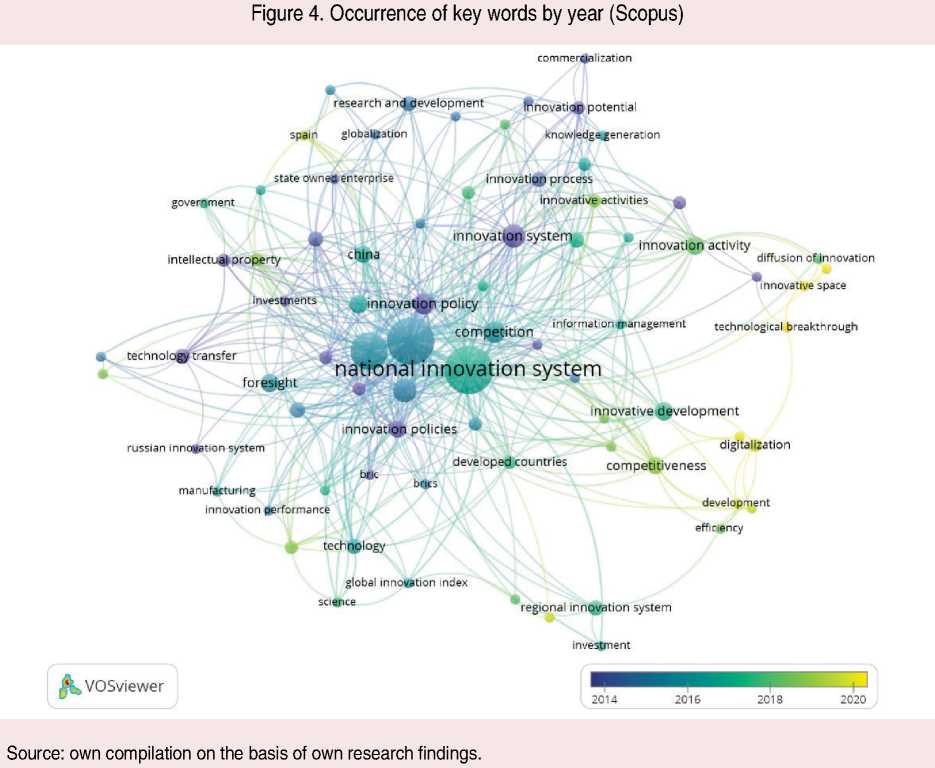
According to Figures 1 and 3, the terms “national innovation system”, “innovation”, “innovation development” and “innovation policy” are most common in the WoS and Scopus databases. Figures 2 and 4 show the evolution in research terminology. The terms “innovation infrastructure”, “leadership”, “digitalization”, “knowledge spillover” are highlighted in yellow, which indicates an increase in their usage in recent publications.
The visual analysis of the bibliographic data helped us clarify key points for the next stage of the study, namely, the application of the PRISMA method.
PRISMA method
We use the PRISMA method to conduct a systematic study of the literature on the chosen topic. The PRISMA method is widely used in many scientific fields, but it has become especially widespread in medicine. In the social sciences, the PRISMA method is applied to a wide range of issues, since it represents a systematic review aimed at identifying, evaluating and interpreting the results of research that is relevant and related to a specific topic to be studied. The implementation of the corresponding procedure implies the sequence of several steps: identification of sources, identification and removal of duplicates, screening and assessment of eligibility [10].
Step 1 – identification of the sources. At this stage, we searched for works in several science citation databases: the international databases Web of Science and Scopus, as well as the Russian
Table 2. Search queries to science citation databases
|
Database |
Search query |
Search restriction criteria |
|
Web of Science |
(“Russian innovation system”) OR (“National innovation system” and Russia) |
Absent |
|
Scopus |
(“Russian innovation system”) OR (“National innovation system” and Russia) |
Absent |
|
ELibrary |
(“Russian innovation system”) OR (“National innovation system”) OR (Национальная инновационная система) OR (Российская инновационная система) |
Search in: the title of the publication. Type of publication: journal articles, dissertations, books, conference materials. Subject: no restrictions. Authors: no restrictions. Journals: no restrictions. Parameters: search based on morphology. Years of publication: no restrictions. Received: for all time |
|
Source: own compilation on the basis of own research findings. |
||
database of the national electronic library eLibrary. The basis consisted of the following key queries “Russian innovation system”, “National innovation system” and Russia; since eLibrary contains a large number of Russian-language publications, these queries were supplemented with their translated counterparts (“национальная инновационная система” and “российская инновационная система”). We did not apply restriction criteria at the identification stage for the Scopus and Web of Science databases; the following advanced search parameters were set for eLibrary: inclusion of a key query in the title of publication, publication type – articles in journals, dissertations, books, conference materials. Search queries and exclusion parameters are formulated in Table 2 .
This step allowed us to identify 1,379 scientific sources. Additionally, other publications identified during the search in the above databases, as well as in the Google Scholar system, were included – this increased the total research base by 232 units. In total, 1,611 publications were selected at the identification stage.
Step 2 – identifying and deleting duplicates. In the course of checking the research base for duplicates, 301 works were identified and deleted, therefore, 1,310 sources remained for further consideration.
Step 3 – screening. This stage includes checking publications for compliance with the topic. We excluded materials that did not meet the basic inclusion criteria, according to which the topic of the work relates to the study of national innovation systems, or the work contains a model of the national innovation system. We also excluded materials that cannot be considered in full text either because there is no access to them or the publications are in languages other than Russian and English. This allowed us to discard another 1,173 sources, leaving only 137 for further consideration. Thus, already at this stage, only 8.5% of the works from the initial sample were submitted for analysis.
Step 4 – assessment of eligibility. Verification involves identifying scientific sources that contain mathematical models of national innovation systems. Consequently, those works that contain only a conceptual description of NIS, a simple description of relevant statistics, that is, do not offer a specific formal analysis, were subject to exclusion. This reduced the original sample by another 88 sources. In the future, using qualitative analysis, we excluded ten publications that did not meet the search criteria. In total, 39 papers were selected for final consideration – 2.4% of the initial number of publications.
The PRISMA flowchart is shown in Figure 5.
Figure 5. PRISMA flowchart

Publications identified by key queries in databases
Web of Science, Scopus, ELibrary (n = 1,379)
Additionally identified publications (n = 232)



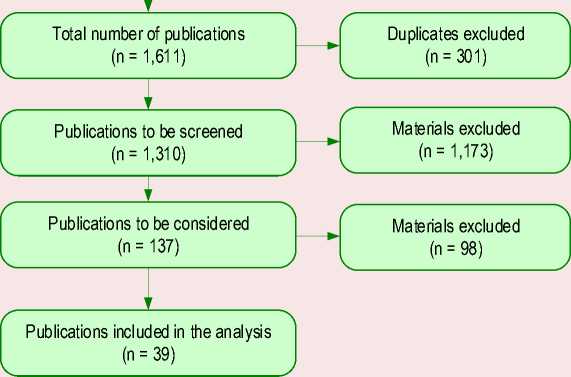
Source: own compilation on the basis of own research findings.
Typology of NIS models
In the course of a content-related analysis of the selected scientific literature, we classified models into four types based on the generality of conclusions: macroeconomic modeling of innovation systems, modeling of growth due to the development of innovation systems, modeling of innovation activity of firms, modeling of institutional drivers of development of innovation systems (Fig. 6) .
Each of the selected varieties includes many approaches to NIS modeling. Thus, macroeconomic modeling of innovation systems is often carried out using patenting indicators (the number of registered patents, filed applications), production and economic indicators (output and export of high-tech products, GDP, investment and R&D expenditures), publication activity indicators (the number of research papers). When modeling growth due to the development of innovation systems, the latter are reflected as indicators of GDP and its derivatives (growth rates, labor productivity, GDP per capita) and as global competitiveness indices, HDI, Gini coefficient. Modeling of innovation activity of firms is focused on studying the features of innovation activity of actors at the micro-level; therefore, first of all, what is taken into account includes innovation strategies of firms, types of their cooperation in the framework of creation of innovation, the expectation of participants’ gains and their perception of obstacles, as well as the corresponding indices. Regarding the institutional factors in innovation systems, it is useful to take into consideration the previously mentioned macro-indicators of patenting, production, GDP, innovation indices, and microlevel indicators, in particular innovation strategies of organizations.
Figure 6. Typology of NIS models
Type of models
Resulting variable
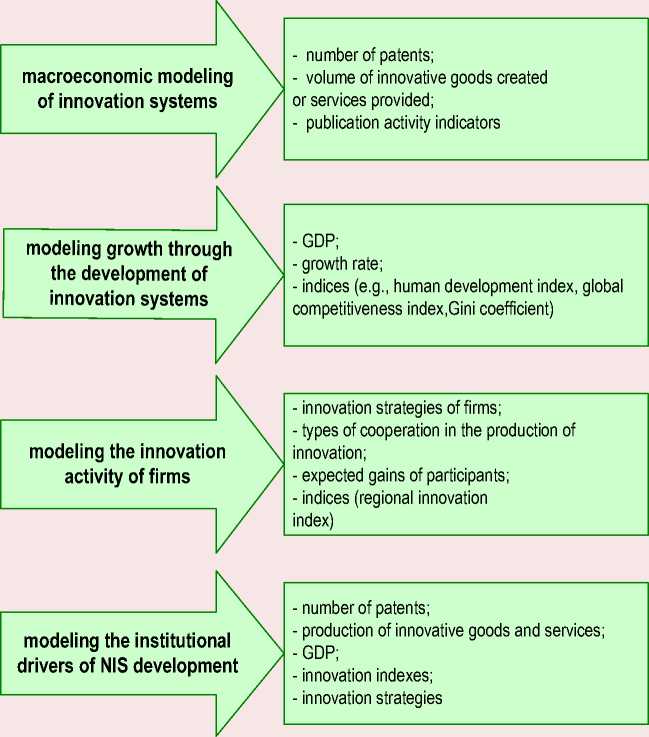
Source: own compilation on the basis of own research findings.
This classification helps us typologize the sets of approaches and variables that are used in the scientific literature. In further research, this typology can be supplemented and expanded by increasing the volume of analyzed information and conducting interdisciplinary research in this direction.
Macroeconomic modeling of innovation systems
A popular variable reflecting NIS is the volume of innovative goods or services created, that is, the volume of high-tech exports or production and sales of innovative goods (at the level of firms). In various models, this variable shows dependence on a variety of factors characterizing human capital (the number and structure of the workforce and personnel, the level of education), infrastructure (in terms of the use of computers), innovation activity (production of innovative goods, expenditures on R&D, science, investment in innovation, the number of enterprises engaged in the creation of knowledge), institutional structure (government, business conditions), financing (volume of lending) [15; 23–27].
Publication activity indicators (the number of published research papers, citation indicators) as a way of reflecting the functioning of NIS are used less commonly. The determinants here are generally the same factors as in the previously mentioned models: human capital (number of researchers, level of education), investments (R&D expenditures, foreign direct investment, education expenditures), indicators of innovation activity (patent registration, import of high-tech goods) [19; 28].
Modeling growth through the development of innovation systems
When it comes to attempts to model economic development, then there are significantly fewer publications on this topic. As a rule, the proxy variables here are represented by combinations of some factors reflecting economic development, or various indices, for example, the human development index, the Gini coefficient. However, the variables affecting it are generally the same as for economic growth [39; 40].
Historically, in economic theory, economic development is associated with factors and variables that are difficult to quantify, in particular, the state of the institutional structure or the quality of economic policy. Due to the complexity of including such institutional factors in the analysis using formal modeling, it is necessary to supplement mathematical modeling with conceptual modeling using qualitative methods. As noted by the Nobel laureate R. Shiller, in the framework of narrative economics, econometric modeling can be supplemented with qualitative research [41].
Modeling the innovation activity of firms
The models describing innovation activity at the micro-level are very fragmented. This is probably due to the fact that the data for such a study were obtained in the process of using mixed methods: surveys and questionnaires, which forms a heterogeneous sample of initial data, and, therefore, various aspects studied in publications.
D.A. Gordeev and V.V. Akberdina propose another approach based on the expected benefits from participation in innovation processes. Their conclusions, however, are not at variance with the previous ones: the behavior of organizations is determined by a set of regulatory and organizational and managerial factors, that is, the conditions and goals of this activity, as well as interaction with the environment represented by state actors, science and entrepreneurship, and the corresponding restrictions [45]. In general, the importance of the state as one of the parties to ensuring political conditions that are taken into account by an individual when making decisions regarding investments (in this context, as the development of technology transfer) is emphasized in the work of B.E. Odintsov, in which the researcher points out that investors’ interest increases with external political and economic stabilization, as well as stabilization of the federal level of government [46].
The availability and localization of resources are also important in modeling innovation activity. In addition, financing plays a key role for enterprises, unlike institutional representatives who find that the education factor is more important for innovation development [47]. A broader view of the obstacles to innovation from the point of view of firms involves taking into account additionally such factors as unfavorable environmental conditions, detachment from innovation interaction, intra-company factors (including the problem of human capital), high risks, flaws in infrastructure [48].
Modeling institutional drivers of innovation systems development
It is noteworthy that even with the relative homogeneity of approaches to the reflection of NIS in models, the conclusions obtained from empirical data vary greatly even with respect to the basic aspects that are considered determinants of innovation activity.
The question of the need and role of government spending seems to be difficult, given that firms tend to note just the need for resources as a key factor affecting their activities in the field of innovation [47], and the lack of financial resources and government support as one of the main obstacles to these activities [48].
Another factor influencing innovation activity is the system of property rights protection. It is obvious that actors have more incentives to create new goods and services when there are guarantees that their innovations are protected from copying, expropriation, etc. Nevertheless, when studying findings of the studies involving this aspect, one may encounter somewhat heterogeneous conclusions. Although the complexity of the property rights protection system has a positive effect on the involvement of firms in the exchange of knowledge, at the same time we should note that this aspect requires more detailed research; moreover, it was revealed that a significant number of enterprises recognize this same factor as an obstacle to the exchange of technological achievements [49]. On the other hand, there is evidence of a significant and positive impact of the property rights protection system on the processes of cooperation between industry and the academia, and both formal and informal instruments are important in this regard [44]. At the same time, modeling the dependence of labor productivity on a number of indicators characterizing the openness of the national innovation system has revealed such factor as the cost of using intellectual property does not have a significant impact on the regressand [38].
The importance of institutional factors for innovation is also investigated in the context of ownership forms that promote or hinder innovation activity. The failures of the national innovation policy in terms of non-fulfillment of the function of creating, storing, distributing and economically applying knowledge are caused by the distortion of the motivation of actors due to the flaws in the institutional structure, for example, in institutions related to intellectual property [52].
Another contradiction is observed regarding the question of assessing the importance of the institutional structure in the context of national innovation systems and their impact on economic growth. As a rule, it is assumed that institutions are important for economic development [53; 54; 55].
It is also logical to assume that developed institutions have a positive impact on innovation processes. On the one hand, some empirical studies confirm this fact. Thus, S. Zemtsov and M. Kotsemir come to the conclusion that institutional conditions provide the best opportunities for interaction between actors in the innovation process [21]. On the other hand, some models show that the institutional component is insignificant [36; 40]. S.M. Pyastolov in his article demonstrates a model of the impact of various factors on the index of innovation output, where the coefficient for a variable of institutions takes a negative value [56].
Conclusion
The relational analysis of publications that we have conducted allows us to present a picture of research devoted to the modeling of innovation systems. The study of innovation systems is within the research field of several sciences, with most of them in economics, econometrics and finance, business, management and accounting, and the social sciences. Having analyzed scientometric indicators, we reveal that in recent years there has been an increase in publications on this topic, accompanied by an increase in references related to the topic of key words in scientific publications.
Studies of national innovation systems in modern economic theory focus on the mechanisms, quantitative results, and indicators of the functioning of organizations. Qualitative analysis and interpretation of the articles helped us to identify and establish four main aspects of national innovation systems modeling: on the one hand, NIS macro-models and modeling economic growth through the development of innovation systems, and on the other hand – modeling institutional drivers of innovation systems development and modeling the innovation activity of firms.
The analysis of variables of the above types of models is important for understanding formal modeling, an essential aspect in the study of national innovation systems. The variables of the considered types of models will be used in the future to organize the collection and analysis of qualitative data within the framework of narrative economics, the newest scientific direction. In this regard, the results obtained in the course of our work are necessary when formulating queries in the databases of mass media, conducting content analysis, and formulating questions in the guides of in-depth interviews. Conducting qualitative research into the Russian innovation system based on the analysis of narratives allows, along with its formal modeling, to gain a deeper understanding of the processes in the field of creation and implementation of innovation.
Список литературы Investigating the Approaches to National Innovation Systems Modeling
- Romer P.M. Increasing returns and long-run growth. Journal of Political Economy, 1986, no. 94, pp. 1002–1037.
- Romer P.M. Why, indeed, in America? Theory, history, and the origins of modern economic growth. American Economic Review, 1996, no. 86(2), pp. 202–206.
- Nelson R.R., Romer P.M. Science, economic growth, and public policy. Challenge, 1996, vol. 39, no. 1, pp. 9–21
- Golichenko O.G. National innovation systems: From conception toward the methodology of analysis. Voprosy ekonomiki, 2014, no. 7, pp. 35–50 (In Russian).
- Lundvall B.Å. Innovation as an interactive process: from user-producer interaction to the national systems of innovation. In: The Learning Economy and the Economics of Hope. Ed. by B.Å. Lundvall. London, New York, NY: Anthem Press, 2016. P. 61.
- Van der Heijden J., Kuhlmann J. Studying incremental institutional change: A systematic and critical metareview of the literature from 2005 to 2015. Policy Studies Journal, 2016, no. 45(3), pp. 535–554.
- Kreshpaj B., Orellana C., Burström B., Davis L., Hemmingsson T., Johansson G., Bodin T. What is precarious employment? A systematic review of definitions and operationalizations from quantitative and qualitative studies. Scandinavian Journal of Work, Environment & Health, 2020, no. 46(3), pp. 235–247.
- Figueiredo F., Rocha L., Couto T., Salles T., Gonçalves M. A., Meira Jr W. Word co-occurrence features for text classification. Information Systems, 2011, no. 36 (5), pp. 843–858.
- Lee P. C., Su H.N. Investigating the structure of regional innovation system research through keyword co-occurrence and social network analysis. Innovation, 2010, vol. 12, no. 1, pp. 26–40.
- Liberati A., Altman D.G., Tetzlaff J., Mulrow C., Gøtzsche P. C., Ioannidis J. P., Moher D. The PRISMA statement for reporting systematic reviews and meta-analyses of studies that evaluate health care interventions: Explanation and elaboration. Journal of Clinical Epidemiology, 2009, no. 62 (10), pp. 1–34.
- Zelenkov Y.A., Sharsheeva J.A. Impact of the investment in supercomputers on national innovation system and country’s development. In: International Conference on Parallel Computational Technologies. Cham: Springer, 2017. Pp. 42–57.
- Perret J.K. Re-evaluating the knowledge production function for the regions of the Russian Federation. Journal of the Knowledge Economy, 2019, vol. 10, no. 2, pp. 670–694.
- Nasierowski W., Arcelus F.J. On the efficiency of national innovation systems. Socio-Economic Planning Sciences, 2003, vol. 37, no. 3, pp. 215–234.
- Juřičková E., Pilik M., Kwarteng M.A. Efficiency measurement of national innovation systems of the European Union countries: DEA model application. Journal of International Studies, 2019, no. 12 (4), pp. 286–299.
- Kornev V. et al. National innovation system: Experience of formation, revealing patterns of development, regulation. Mediterranean Journal of Social Sciences. Rome: MCSER Publishing, 2015, vol. 6, no. 6.
- Pan T.W., Hung S.W., Lu W.M. DEA performance measurement of the national innovation system in Asia and Europe. Asia-Pacific Journal of Оperational Research, 2010, vol. 27, no. 3, pp. 369–392.
- Matrizaev B.D. Study of the comparative efficiency of the national innovation system and the quality of economic growth: on the example of a comparative analysis of OECD and BRICS countries. Voprosy innovatsionnoi ekonomiki=Russian Journal of Innovation Economics, 2019, vol. 9, no. 3, pp. 673–692 (In Russian).
- Bacon D., Forner D., Ozcan S. Machine learning approach for national innovation performance data analysis. In: 8th International Conference on Data Science, Technology and Applications. SciTePress, 2019, pp. 325–331.
- Mikhaylov A.S. et al. Knowledge geography for measuring the divergence in intellectual capital of Russia. Electronic Journal of Knowledge Management, 2020, vol. 18, no. 2, pp. 121–135.
- Mikhailov A.S., Kuznetsova T.Y., Peker I.Y. Methods of spatial scientometrics in assessing the heterogeneity of the innovation space of Russia. Perspektivy nauki i obrazovaniya, 2019, no. 5 (41), p. 549.
- Zemtsov S., Kotsemir M. An assessment of regional innovation system efficiency in Russia: The application of the DEA approach. Scientometrics, 2019, vol. 120, no. 2, pp. 375–404.
- Ervits I. et al. Economic potential of internationally-oriented patenting activity in Russia. Entrepreneurial Business and Economics Review, 2019, vol. 7, no. 1, pp. 75–94.
- Afzal M.N.I. An empirical investigation of the National Innovation System (NIS) using Data Envelopment Analysis (DEA) and the TOBIT model. International Review of Applied Economics, 2014, vol. 28, no. 4, pp. 507–523.
- Aivazyan S.A. et al. On the issue of parametrization of the national innovation system. Prikladnaya ekonometrika=Applied Econometrics, 2017, no. 1 (45), pp. 29–49 (In Russian).
- Pogodaeva T.V., Zhaparova D.V. A model for innovation development of Russia: The role of the oil and gas business. Issledovaniya molodykh uchenykh: ekonomicheskaya teoriya, sotsiologiya, otraslevaya i regional’naya ekonomika=Young Scientists’ Research: Economic Theory, Sociology, Sectoral and Regional Economics, 2015, pp. 260–266 (In Russian).
- Serdyukova Yu.S. et al. Assessing the innovation system in Russian regions: present state and further development. Region: ekonomika i sotsiologiya=Region: Economics and Sociology, 2010, no. 1, pp. 179–197 (In Russian).
- Khrustalev E.Yu., Slavyanov A.S. Innovation-oriented evaluation methodology of the status and potential for growth of national economic system. Politematicheskii setevoi elektronnyi nauchnyi zhurnal Kubanskogo gosudarstvennogo agrarnogo universiteta=Polythematic Online Scientific Journal of Kuban State Agrarian University, 2016, no. 115 (In Russian).
- Mikhailov A.S., Kuznetsova T.Yu., Peker I.Yu. Methods of spatial scientometrics in assessing the heterogeneity of the innovation space of Russia. Perspektivy nauki i obrazovaniya=Perspectives of Science & Education, 2019, no. 5 (41), pp. 549–563 (In Russian).
- Babenko V. et al. The innovation development in China in the context of globalization. WSEAS Transactions on Business and Economics, 2020, vol. 17, no. 2, pp. 523–531.
- Rodionova I.A., Kokuytseva T.V., Semenov A.S. Mathematical model of the influence of innovative development factors on the economy of leading countries and Russia. International Journal of Engineering & Technology, 2018, vol. 7, no. 4 (38), pp. 406–411.
- Sesay B., Yulin Z., Wang F. Does the national innovation system spur economic growth in Brazil, Russia, India, China and South Africa economies? Evidence from panel data. South African Journal of Economic and Management Sciences, 2018, vol. 21, no. 1, pp. 1–12.
- Gackstatter S., Kotzemir M., Meissner D. Building an innovation-driven economy–the case of BRIC and GCC countries. Foresight, 2014, vol. 16, no. 4, pp. 293–308.
- Balatsky E.V. et al. National models of technological development: A comparative analysis. Journal of Institutional Studies, 2017, vol. 9, no. 4, pp. 37–51 (In Russian).
- Fagerberg J., Srholec M. National innovation systems, capabilities and economic development. Research Policy, 2008, vol. 37, no. 9, pp. 1417–1435.
- Bogdanova E.L., Ibragim A. National innovation system and its role in increasing GDP per capita (evidence from Russia). Voprosy regulirovaniya ekonomiki=Journal of Economic Regulation, 2018, vol. 9, no. 1, pp. 33–39 (In Russian).
- Ermoshina T.V. The cost of technological innovation as a priority factor in the development of the national innovation system. Vestnik evraziiskoi nauki=The Eurasian Scientific Journal, 2019, vol. 11, no. 3 (In Russian).
- Ovchinnikova A.V. National innovation system. Vestnik Udmurtskogo universiteta. Seriya “Ekonomika i pravo”=Bulletin of Udmurt University. Series Economics and Law, 2012, no. 4, pp. 61–69 (In Russian).
- Tseluiko A.A. Open national innovation system and economic growth. Innovatsionnoe razvitie ekonomiki=Innovation Development of the Economy, 2017, no. 6, pp. 203–212 (In Russian).
- Ibrahim A. Impact national innovation system on the innovation capabilities in Russia. Ekonomika. Sotsiologiya. Pravo=Economics. Sociology. Law, 2016, pp. 3–7 (In Russian).
- Bogdanova E.L., Alnafrah I. Analysis impact structure of national innovation system factors on the development process in Russia. Izvestiya Volgogradskogo gosudarstvennogo tekhnicheskogo universiteta=Izvestia Volgograd State Technical University, 2017, no. 15, p. 19 (In Russian).
- Shiller R.J. Popular economic narratives advancing the longest U.S. expansion 2009–2019. Journal of Policy Modeling, 2020, no. 42 (4), pp. 791–798.
- Lundvall B.Å. National innovation systems – analytical concept and development tool. Industry and Innovation, 2007, vol. 14, no. 1, pp. 95–119.
- Lundvall B.Å. Innovation System Research: Where It Came from and where It Might Go. Georgia Institute of Technology, 2008, 51 p.
- Roud V., Vlasova V. Strategies of industry-science cooperation in the Russian manufacturing sector. The Journal of Technology Transfer, 2020, vol. 45, no. 3, pp. 870–907.
- Gordeev D.A., Akberdina V.V. Research of mathematical formalization of strategic decision-making in the national innovation system of Russia. In: Strategii razvitiya sotsial’nykh obshchnostei, institutov i territorii [Strategies for the Development of Social Communities, Institutions and Territories]. Volume 1. Yekaterinburg, 2019. Pp. 295–301 (In Russian).
- Odintsov B.E. Management of spiral dynamics in the development strategy of the national innovation system. Strategii biznesa=Business Strategies, 2017, no. 1, pp. 3–8 (In Russian).
- Vlačić E., Dabić M., Aralica Z. National innovation system: Where do government and business diverge? Drustvena Istrazivanja, 2018, vol. 27, no. 4, pp. 649–669.
- Gokhberg L., Roud V. Structural changes in the national innovation system: Longitudinal study of innovation modes in the Russian industry. Economic Change and Restructuring, 2016, vol. 49, no. 2, pp. 269–288.
- Savitskaya I., Salmi P., Torkkeli M. Outbound open innovation in China and Russia: Innovation system approach. International Journal of Business Innovation and Research, 2014, vol. 8, no. 2, pp. 190–209.
- Khalimova S. Innovation development of large companies in Siberia. Area Development and Policy, 2016, vol. 1, no. 3, pр. 378–388.
- Tambovtsev V.L. Innovations and culture: Importance of the analysis methodology. Voprosy ekonomiki, 2018, no. 9, pp. 70–94 (In Russian).
- Golichenko O.G. Public policy and national innovation system failures. Voprosy ekonomiki, 2017, no. 2, pp. 97–108 (In Russian).
- North D.C. Institutions, Institutional Change, and Economic Performance. Cambridge and New York: Cambridge University Press, 1990.
- Acemoglu D., Johnson S., Robinson J. A. Institutions as a fundamental cause of long-run growth. Handbook of Economic Growth, 2005, no. 1, pp. 385–472.
- Greif A. Institutions and the Path to the Modern Economy: Lessons from Medieval Trade. Cambridge and New York: Cambridge University Press, 2006.
- Pyastolov S.M. Effectiveness of the national innovation system: Infrastructure aspect. Transportnoe delo Rossii=Transport Business of Russia, 2012, no. 6–1, pp. 18–20 (In Russian).

